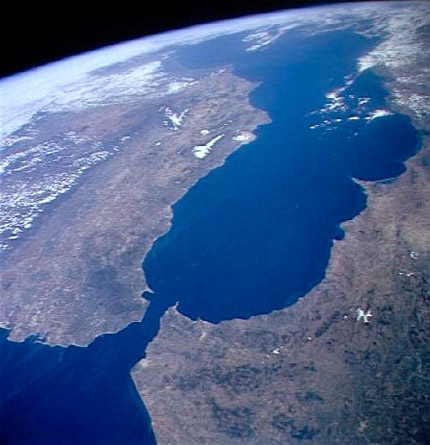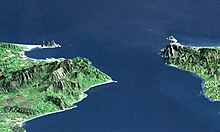
The Strait of Gibraltar crossing is a hypothetical bridge or tunnel spanning the Straits of Gibraltar that would connect Europe and Africa. The governments of Spain and Morocco appointed a joint committee[1] to investigate the feasibility of linking the two continents[when?]. This resulted in the much broader Euromed Transpor
Several engineers have designed bridges on various alignments and with differing structural configurations. Professor T.Y. Lin’s proposal for a crossing between Point Oliveros and Point Cires featured deep piers, a length of 14 kilometres (8.7 mi), 910 metres (3,000 ft) tall towers, and a 5,000 metres (16,000 ft) span, more than twice the length of the current longest bridge span.[3]
In 2004, architect Eugene Tsui published his concept for a floating and submerged bridge, connected at a three-mile wide island in the middle of the Mediterranean Sea.[4]
In 2004, the Science Museum published an image of the proposed Gibraltar Straits road bridge.
Various Gibraltar tunnels have been proposed. Spain first proposed a modern tunnel under the Strait of Gibraltar in 1930. A major problem arose when the engineers hired by the Spanish government discovered that the material under the Strait was extremely hard rock, making tunnelling impossible with the available technology.[6] One engineering solution was to fix, using cables, a prefabricated concrete tunnel to the floor of the Strait. This tunnel would handle automotive and train traffic. Nothing came of this proposed solution.[7]
A 2008 geological study cast doubt on the tunnel's practicality. In March 2009, a contract was issued for a joint system linking the Moroccan Société Nationale d'Etudes du Détroit de Gibraltar (SNED) with its Spanish counterpart, Sociedad española de estudios para la comunicación fija a través del Estrecho de Gibraltar S.A (SECEGSA). A three-year study for a railway tunnel was announced in 2003. SNED and SECEGSA commissioned several sea-bed surveys.
The Strait depth extends to 900 metres (3,000 ft) on the shortest route, although it is only about 300 metres deep slightly further west, where the European and African plates meet. The shortest crossing is 14 kilometres (8.7 mi). The proposed route of 23 kilometres (14 mi) is west of Tarifa and to the east of Tangier. The tunnel is likely to be about 34 kilometres (21 miles) in all. A connection would have to be made to the Spanish high speed railway network, which has a line projected to be built from Cádiz to Málaga via Algeciras.
A report[8][9][10] on the feasibility of the tunnel was presented to the EU in 2009. A further project study is under development by a group of specialist consultants from SYSTRA, Amberg and COWI.[citation needed]
Planning
In December 2003, Spain and Morocco agreed[11][12] to explore the construction of an undersea rail tunnel to connect their rail systems. The tunnel would have linked Cape Malabata near Tangier with Punta Paloma in the El Estrecho Natural Park 40 kilometres (25 mi) west of Gibraltar.[13] In late 2006, Lombardi Engineering Ltd, a Swiss engineering and design company, was retained to draft a design for a railway tunnel.[14] According to the company, the main differences between the construction of this tunnel and that of the Channel Tunnel, linking France and Great Britain, are the depth of the sea and the geological conditions. The area under the Strait is less stable than that under the English Channel. An active major geologic fault, the Azores-Gibraltar Transform Fault, bisects the Strait, and severe earthquakes have occurred in the area. The presence of two deep Quaternary clay channels in the middle of the Strait makes construction complex,[8] causing doubts about the feasibility of the project and proposals for an exploratory tunnel.[15]It is projected to carry 9 million passengers in its first year of operation, expected to be 2025. No official figures about the cost of the project had been announced by 2007, but previous estimates exceeded €5 billion.[16]





0 comments: